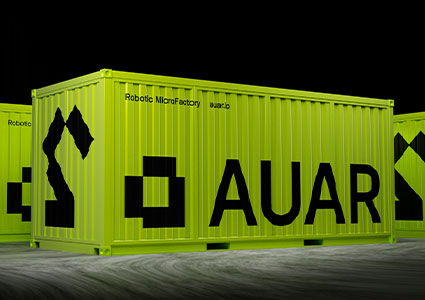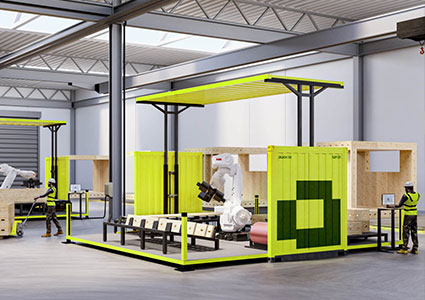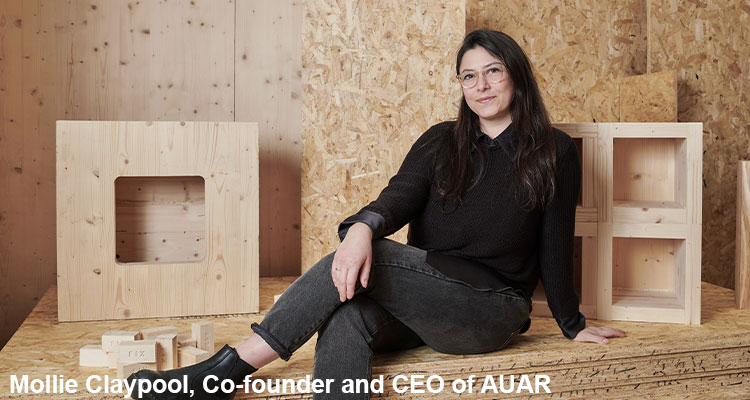Mollie Claypool shares how Automated Architecture is building a global, automated construction ecosystem for sustainable, affordable and beautiful homes at scale
Could you start with some details about your career history, and its evolution to your current role?
I studied architecture at Pratt Institute in New York City and architecture theory in London, where I graduated from the Architectural Association. Since then, I’ve been an active member of the academic community as an Associate Professor at The Bartlett School of Architecture, UCL, where I have co-directed the award-winning AUAR Labs, which won Architect Journal’s Social Sustainability Award in 2021. I have also been a visiting professor at the Cluster for Excellence Integrative Computational Design and Construction for Architecture at the University of Stuttgart and was a faculty member at the AA School of Architecture. As an author, I co-wrote “Robotic Building: Architecture in the Age of Automation” (Detail Edition 2019) and authored the SPACE10 report “The Digital in Architecture: Then, Now and in the Future” (2019).
 Automated Architecture (AUAR) was founded in 2019 with my co-founder Gilles Retsin after we worked together for over a decade researching how robotics, generative design, and AI could radically transform the way we build so we can change how we live.
Automated Architecture (AUAR) was founded in 2019 with my co-founder Gilles Retsin after we worked together for over a decade researching how robotics, generative design, and AI could radically transform the way we build so we can change how we live.
Outside of AUAR, I am also a practising birthkeeper and a Community Elder for Doulas Without Borders, advising volunteers to support the most vulnerable birthing people in UK society. I am a mother to two small kids, and in my spare time, I can be found working with my hands in a community allotment.
Tell me more about AUAR and where your role fits in the business?
AUAR is building a global, automated construction ecosystem for housing. We partner with homebuilders, developers and manufacturers, who get access to our tech stack of Robotic Micro-Factories and AI-powered design-to-manufacturing software. Our partners use our tech to increase efficiencies, predictability and oversight, while significantly reducing financial risk and environmental costs, when building timber homes.
AUAR is the only construction tech company genuinely enabling the existing industry to deliver sustainable, affordable and beautiful homes at scale.
As the CEO of a construction tech startup, I feel like I’m playing a multifaceted role, combining business acumen, industry know-how, and tech leadership to guide the company toward sustainable growth and innovation. In an industry traditionally slow to adopt new technologies, we’re using AI and automation to revolutionize how construction projects are managed and as CEO my job is making sure we offer solutions that will improve efficiency, reduce waste, and drive profitability for our clients.
Tell me more about the Robotic Micro Factories – explain their tech and how they work?
Each Micro-Factory container has one ABB robot arm and additional proprietary hardware developed by AUAR for the robot such as its end effector, automated saw and assembly table. The robot arm starts by scanning piles of sheet material and timber lengths to gain insights on the positioning of materials within the container. The robot then starts cutting standard timber lengths into precise components. This is done using AUAR’s automated saw within the container that ensures accuracy and minimizes waste. Once the timber lengths are cut, the robots assemble the timber lengths and standard timber sheets into timber frame panels. This highly automated process includes tasks such as nailing and lifting, all handled by the robots.
Throughout the process, the Micro-Factory, which is equipped with vision systems and AI, performs continuous quality checks. The flexibility of the robotic systems in the container allows for customization of the modular units. This means that homes produced by an AUAR Micro-Factory can be tailored to specific designs and requirements without any changes to the production process. After assembly, the timber frame panels are transported to the construction site, where they are quickly and efficiently put together to form the final structure.
AUAR’s software platform is comprised of design-for-manufacture and assembly micro-services that AUAR and its partners use to automate the collection of design requirements, building code and supply chain information, and automatically produce full design specifications including construction details, bills of materials, the manufacturing code for the Micro-Factories and installation sequencing instructions.
How will Rival Holdings be using these to build sustainable and affordable homes?
Rival will be using the Micro-Factories to deliver thousands of homes across the Midwest, in the US.
Where are they based, and is this area in particular need for homes, or is this solution suitable for across the US?
AUAR’s project caters to a growing need in the region – there is a significant affordability crisis nationally. The partnership between AUAR and Rival Holdings aims to address the ongoing housing crisis in the US. The collaboration will focus on producing sustainable homes that are not only affordable but also built to high standards, ensuring durability and environmental efficiency. The solution is suitable for use across the US.
Focusing on the homes themselves – can you elaborate on what they are like/include? Do you have any ideas of price range at this stage?
Unlike existing solutions, AUAR’s Micro-Factories don’t require big factories to be set up and have a quick lead time of 12 weeks from order to shipping. We offer a flexible, No CapEx ‘hardware-as-a-service’ model for our pop-up Robotic Micro-Factories so our partners can quickly get set up without large capital expenses. AUAR remote-support partners with our AI-powered software all the way from design to manufacturing, automating thousands of hours of inefficient, manual processes in the home building process.
We have designed our Micro-Factory solution to be truly accessible to homebuilders and we do this by keeping the upfront costs low and allowing for quick installation and delivery. The operation of the Micro-Factory itself doesn’t require extensive training or knowledge of robotics, our software and team take care of everything from the initial designs down to manufacturing.
We can work with our customers to get costs down by 30-to-40 percent from market cost in comparison to traditional construction. 
Do you anticipate the homes will get more sophisticated as the technology advances?
The homes are already of the highest quality in terms of sustainability and design. We of course will refine this over time as we learn more from each geography in which we operate.
Do the homes also feature any sustainable options, such as heating or materials?
AUAR homes are specified to work with air source or thermal heat pumps and solar panels and use biomaterials wherever possible.
Mollie Claypool
auar.io
Mollie Claypool is Co-founder and CEO of AUAR, an automated construction platform for sustainable housing. AUAR is the only construction tech company that has cracked both the technology and the business model to scale. The whole construction value chain – homebuilders, developers and manufacturers – rely on its platform from design to manufacturing. The company has developed a product suite of Robotic Micro-Factories and AUAR MasterBuilder, a design-to-manufacturing software, that increases opportunity, efficiencies, predictability and oversight, while significantly reducing financial risk and environmental costs. This approach enables customers to deliver on the housing demand that currently outpaces the market’s ability to supply. Customers access the platform through its ‘No Capex’ Hardware-as-a-Service/Design-as-a-Service business model. By 2030 AUAR will grow to over £1 billion in revenue with over 100,000 carbon-negative homes being produced by customers in more than ten geographies.
